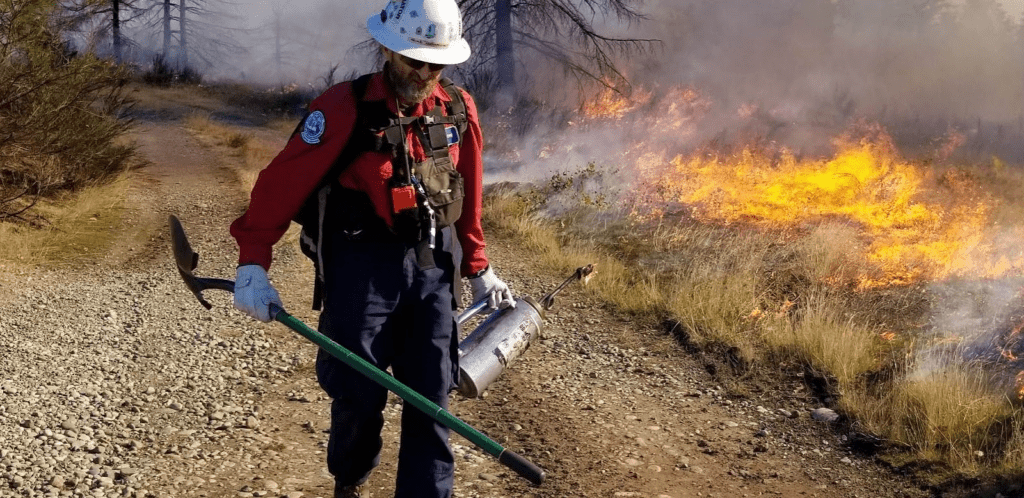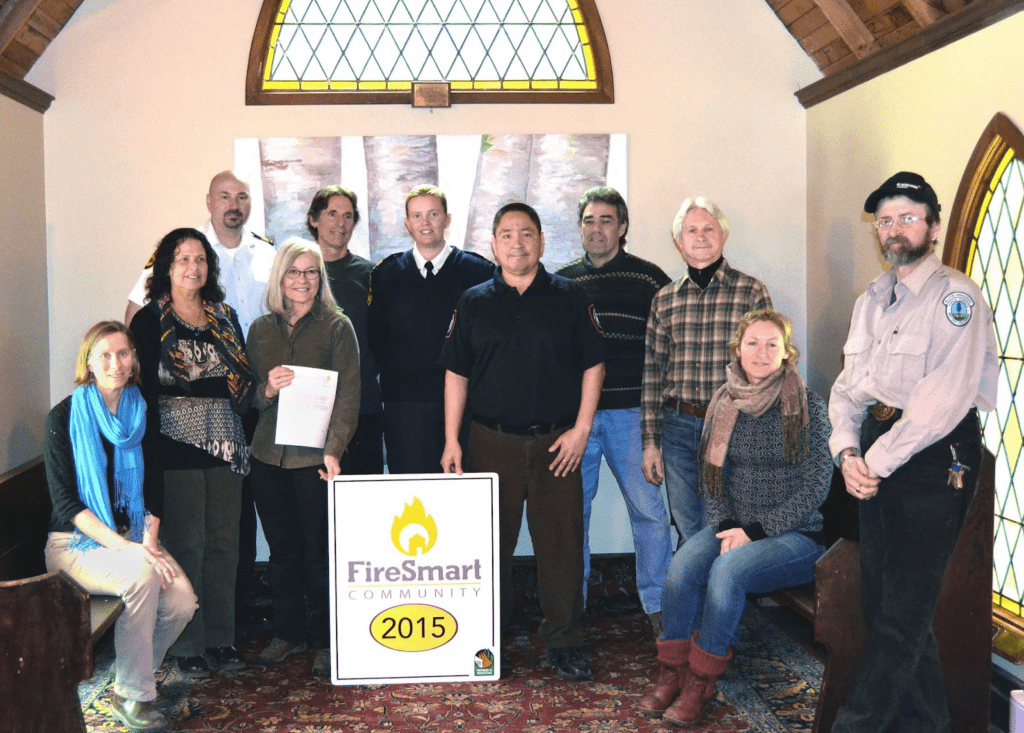While fire is essential for the ecosystems found in British Columbia, uncontrolled wildfires can threaten lives, infrastructure, and resources. In a province that experiences an average of 1,352 wildfires per year, proper fire management techniques are crucial for preserving nature while protecting people and property. That’s why the BC Wildfire Service is tasked with managing wildfires through a combination of wildfire suppression, mitigation, and prevention strategies, including prescribed fire.
When it comes to experience with wildfire and prescribed fire, few can match the knowledge and expertise of Mike Morrow. With 40 years of experience throughout the forestry sector, Morrow has detailed knowledge of wildfire, how it spreads, how it can be safely managed, and how to mitigate the risks associated with it.
Morrow joined the BC Wildfire Service in 1984 in Merritt, BC, starting as an auxiliary silviculture technician. Shortly after joining, he graduated from Selkirk College in 1986 with a diploma in Forestry. Morrow spent three years in Merritt before chasing other opportunities in Nakusp, Port McNeil, Vanderhoof, and Cranbrook. He worked in the protection branch in 1996 as a wildfire technician before becoming a wildfire prevention officer in 2013, a role he continues to perform today.
As a wildfire prevention officer in the Southeast Fire Centre, Morrow focuses primarily on fuel management activities, including prescribed fire. Throughout his 40-year career, Morrow has earned the respect of his colleagues and the following certifications:
- Registered Forest Technician
- Type 1 Fire Behaviour Specialist
- Type 1 Ignition Specialist
- Type 1 Prescribed Burn Boss

While Morrow has accomplished much throughout his career, a highlight has been carrying the torch for prescribed fire and educating both employees and the public on the benefits of this proactive model of wildfire management. “Back in the day, it was a standard practice to conduct prescribed fire,” says Morrow. “Harvesting companies would do it, for example. Then, in the early 90s, it was shut down due to problems with smoke and burning crown timber. A lot of these problems were the result of poor burning practices. That has completely changed today.”
This change is due to the comprehensive legislation that now covers many of these issues. For example, the Open Burning Smoke Control Regulation (OBSCR) ensures that all burning is conducted to mitigate risk to human and environmental health by minimizing smoke.
Another modern method to mitigate risk is the Ventilation Index, a forecast released daily by Environment and Climate Change Canada. With this forecast, anyone can predict the direction and distance that smoke will travel before it starts to settle. “These are methods we did not have in the early days,” says Morrow. “These tools help to ensure that when we do a prescribed burn, we aren’t negatively impacting people with smoke or other issues.”
Morrow recalls that prescribed fire experienced a significant resurgence in the mid 90s due to the pine beetle epidemic that impacted the northwest corner of the province. Since fire suppression tactics weren’t effective, new options were needed. It was here that Mike Pritchard, a close friend and colleague of Morrow, suggested fighting fire with fire. “At the time, everyone thought this idea was insane,” said Morrow. “When the idea was finally approved, however, we learned that doing ignitions on wildfires made the job safer and a lot more efficient.”
Today, for most large incidents, there is an ignition specialist on site to determine the best solution for managing and suppressing a wildfire. As both a fire behaviour specialist and ignition specialist, Morrow looks at every fire with two different perspectives. “When I get on a helicopter and look at a fire, one eye is looking at fuels, fire behaviour, and smoke,” says Morrow. “The other eye is looking for opportunities where we can use prescribed fire to quickly and efficiently contain that division.”
Though some may view prescribed fire as simply lighting a random fire with the hope that it produces desirable results, the reality is that the process is far more complex and involved. When prescribed fire is deemed the most appropriate mitigation strategy, a significant amount of planning and engagement with partners like First Nations and other communities is conducted in advance to ensure that all objectives and considerations are included in the prescription. These projects can take many months or even several years to plan depending on the size, complexity and objectives.
In addition to the mitigation and safety benefits offered through prescribed fire, there are also significant ecosystem benefits. “Within six weeks of performing a burn, the whole site is knee-high in green grass and flowers,” says Morrow. “I call that my happy place. The site was once unhealthy and potentially dangerous, so we burned it. Now, it’s healthier and more beautiful than ever. In some cases, we even find species of plants that were thought to not exist on those sites during our post-burn analysis. By doing the burning, we’re able to have other species come in that have been formerly suppressed, increasing the diversity of the area.”
While prescribed fire is an effective tool for mitigating risk and increasing ecosystem health, wildfires can still pose a significant threat to communities throughout the province. As someone who has seen hundreds—if not thousands–of fires over 40 years, Morrow has noticed that wildfires have changed over time.
“The biggest changes I see are that fires are getting bigger faster,” says Morrow. “That makes them much harder to control. Many of them are also threatening communities now. For example, if we go back 25 years, Salmon Arm was put on an evacuation alert. That was one of the few times I had ever heard of an evacuation of a community like that. Today, due to the nature of the fires and their behaviour, we’re needing to evacuate more communities for their safety.”
The increase in evacuations has emphasized the importance of FireSmart and the steps homeowners can take to improve the fire resilience of their property. While FireSmart wasn’t discussed much a decade ago, it has gained significant traction and is now actively embraced by many homeowners throughout the province and the rest of the country. Some homeowners may think the tasks associated with making a home FireSmart are overwhelming, so Morrow suggests taking it one step at a time.
“Making your property FireSmart is well worth the effort,” says Morrow. “Sometime in the future, your property will be impacted by a wildfire. Do one little thing one weekend and do another thing the next. Don’t wait until the large fires have arrived. When you’re on an alert, you should be ready to pack, your home should be FireSmart, and you should feel comfortable leaving your home in the best shape possible for us to help protect it.”
With 40 years of wildfire experience, it’s no surprise that Morrow is a strong advocate for FireSmart. Just as the BC Wildfire Service is committed to increasing the fire resilience of the land surrounding a community through mitigation strategies, he hopes that homeowners will do their part to keep their properties safe. “It’s just the neighbourly thing to do, both for yourself and those around you,” says Morrow.

When asked to reflect on his time with the BC Wildfire Service, Morrow emphasizes that this profession is one where passion plays a crucial role. “I want people to understand that this profession is not just a job, it’s a career,” says Morrow. “While a job is something you do just to get paid, a career is something that you enjoy and have a passion for. In the fire community, we’re all there for a common goal and are committed to the common good. From the person running the warehouse to the incident commander, we’re all involved and doing the very best work we can. It’s not easy work, but it’s something we’re all passionate about.”
After a long and satisfying career, Morrow is set to retire from the BC Wildfire Service in November of 2023. Before his retirement, he plans to finish strong and impart as much information about FireSmart and prescribed burning as possible. “From now until when I retire, I’m going to try and get as much knowledge out there as I can through coaching and mentoring,” says Morrow. “I want to try to get everything out of my head before I go so the right individuals can keep running with the torch.”
Click here to listen to episode 25 of the Get FireSmart Podcast featuring Mike Morrow.
Click here to learn more about Cultural and Prescribed Fire.
Click here to learn more about FireSmart BC.
